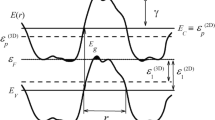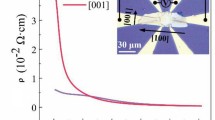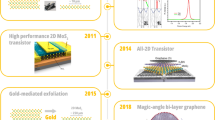Abstract
γ-Phase group IV monochalcogenides (γ-MX), predicted to be stable with semiconducting characteristics, have been synthesized by chemical vapor deposition but showing metallicity. The ubiquitous topological defects introduced during the growth process could bring about key influences on the electronic behaviors, but their structures and properties remain unexplored. Taking monolayer γ-GeSe as an example, first-principles calculations were performed to investigate the structural, thermodynamic, and electronic properties of dislocation cores (DCs) and grain boundaries (GBs). Various derivative DCs emerge depending on different arrangements of atoms. The calculated low-energy DCs are then used to determine preferential structures of GBs versus tilt angle, with special attention paid to the whole family of 60° twin GBs, showing distinct hexagons or Ge—Ge bonds. Furthermore, electronic structures are calculated for thermodynamically favored 21.8° with closely packed dislocations and 60° twin GBs. Most of them show a strong resonance between the bulk and dislocation states, rendering the systems metallic, while some display semiconducting behaviors with reduced band gap. These electronic properties are universal for other γ-MXs. The simulated scanning tunneling microscopy images show characteristic fingerprints to help identify their existence in practice. Our results show that topological defects in γ-MX with versatile properties should be carefully engineered for their potential applications.

摘要
γ相第四主族单硫化合物(γ-MX)是理论预测出的一种全新的具有半导体特性的稳定结构. 最近, 人们通过化学气相沉积法成功合成了相关材料, 但样品却表现出金属性. 生长过程引入的拓扑缺陷无处不在, 可能会对材料电子行为带来重要影响. 但是, 关于这些拓扑缺陷的结构和性质的研究仍未开展. 以γ相GeSe为例, 我们通过第一性原理计算系统研究了其位错核和晶界的结构、 热力学和电子性质. 结果发现, 不同的原子排布方式可以形成多样的衍生位错核. 基于最低能量的位错核, 我们研究了晶界结构随着倾斜角的变化, 并特别构建了全部可能的60° 孪生晶界, 发现它们具有独特的六边形结构或Ge–Ge键. 进一步地, 针对能量最低的21.8°和60°晶界的电子结构分析发现, 大多数晶界体态和缺陷态之间具有共振作用, 这使得体系表现出金属性质; 而某些结构则仍表现半导体性, 但带隙显著减小. 这些电子性质在其他γ-MX中也普遍存在. 不同晶界的扫描隧道显微镜图像展现出特征性图案, 可以作为表征它们的手段. 我们的结果表明, 应对γ-MX中具有多样性质的拓扑缺陷进行有目的的设计以促进其潜在应用.
Similar content being viewed by others
References
Castro Neto AH, Guinea F, Peres NMR, et al. The electronic properties of graphene. Rev Mod Phys, 2009, 81: 109–162
Fiori G, Bonaccorso F, Iannaccone G, et al. Electronics based on two-dimensional materials. Nat Nanotech, 2014, 9: 768–779
Wang QH, Kalantar-Zadeh K, Kis A, et al. Electronics and optoelectronics of two-dimensional transition metal dichalcogenides. Nat Nanotech, 2012, 7: 699–712
Tan CL, Cao XH, Wu XJ, et al. Recent advances in ultrathin two-dimensional nanomaterials. Chem Rev, 2017, 117: 6225–6331
Deng D, Novoselov KS, Fu Q, et al. Catalysis with two-dimensional materials and their heterostructures. Nat Nanotech, 2016, 11: 218–230
Anasori B, Lukatskaya MR, Gogotsi Y. 2D metal carbides and nitrides (MXenes) for energy storage. Nat Rev Mater, 2017, 2: 16098
Ma S, Cai M, Cheng T, et al. Two-dimensional organic-inorganic hybrid perovskite: from material properties to device applications. Sci China Mater, 2018, 61: 1257–1277
Hou H, Zeng X, Zhang X. 2D/2D heterostructured photocatalyst: Rational design for energy and environmental applications. Sci China Mater, 2020, 63: 2119–2152
Zhao LD, Lo SH, Zhang Y, et al. Ultralow thermal conductivity and high thermoelectric figure of merit in SnSe crystals. Nature, 2014, 508: 373–377
Fei R, Li W, Li J, et al. Giant piezoelectricity of monolayer group IV monochalcogenides: SnSe, SnS, GeSe, and GeS. Appl Phys Lett, 2015, 107: 173104
Zhang S, Liu S, Huang S, et al. Structural and electronic properties of atomically thin germanium selenide polymorphs. Sci China Mater, 2015, 58: 929–935
Wu M, Zeng XC. Intrinsic ferroelasticity and/or multiferroicity in two-dimensional phosphorene and phosphorene analogues. Nano Lett, 2016, 16: 3236–3241
Barraza-Lopez S, Fregoso BM, Villanova JW, et al. Colloquium: Physical properties of group-IV monochalcogenide monolayers. Rev Mod Phys, 2021, 93: 011001
Chang K, Liu J, Lin H, et al. Discovery of robust in-plane ferroelectricity in atomic-thick SnTe. Science, 2016, 353: 274–278
Fei R, Kang W, Yang L. Ferroelectricity and phase transitions in monolayer group-IV monochalcogenides. Phys Rev Lett, 2016, 117: 097601
Haleoot R, Paillard C, Kaloni TP, et al. Photostrictive two-dimensional materials in the monochalcogenide family. Phys Rev Lett, 2017, 118: 227401
He Y, Tang P, Hu Z, et al. Engineering grain boundaries at the 2D limit for the hydrogen evolution reaction. Nat Commun, 2020, 11: 57
Ji Y, Yang M, Dong H, et al. Two-dimensional germanium monochalcogenide photocatalyst for water splitting under ultraviolet, visible to near-infrared light. Nanoscale, 2017, 9: 8608–8615
Kim J, Kim KW, Shin D, et al. Prediction of ferroelectricity-driven Berry curvature enabling charge- and spin-controllable photocurrent in tin telluride monolayers. Nat Commun, 2019, 10: 3965
Zhu Z, Tománek D. Semiconducting layered blue phosphorus: A computational study. Phys Rev Lett, 2014, 112: 176802
Wang H, Qian X. Two-dimensional multiferroics in monolayer group IV monochalcogenides. 2D Mater, 2017, 4: 015042
Kennes DM, Xian L, Claassen M, et al. One-dimensional flat bands in twisted bilayer germanium selenide. Nat Commun, 2020, 11: 1124
Tian XQ, Duan JY, Kiani M, et al. Hexagonal layered group IV–VI semiconductors and derivatives: Fresh blood of the 2D family. Nanoscale, 2020, 12: 13450–13459
Mu X, Pan Y, Zhou J. Pure bulk orbital and spin photocurrent in two-dimensional ferroelectric materials. npj Comput Mater, 2021, 7: 61
Xu B, Deng J, Ding X, et al. Van der Waals force-induced intralayer ferroelectric-to-antiferroelectric transition via interlayer sliding in bilayer group-IV monochalcogenides. npj Comput Mater, 2022, 8: 47
Luo N, Duan W, Yakobson BI, et al. Excitons and electron-hole liquid state in 2D γ-phase group-IV monochalcogenides. Adv Funct Mater, 2020, 30: 2000533
Kim H, Choi HJ. Quasiparticle band structures, spontaneous polarization, and spin-splitting in noncentrosymmetric few-layer and bulk γ-GeSe. J Mater Chem C, 2021, 9: 9683–9691
Lee S, Jung JE, Kim HG, et al. γ-GeSe: A new hexagonal polymorph from group IV–VI monochalcogenides. Nano Lett, 2021, 21: 4305–4313
Zou X, Liu Y, Yakobson BI. Predicting dislocations and grain boundaries in two-dimensional metal-disulfides from the first principles. Nano Lett, 2013, 13: 253–258
Yazyev OV, Chen YP. Polycrystalline graphene and other two-dimensional materials. Nat Nanotech, 2014, 9: 755–767
Najmaei S, Liu Z, Zhou W, et al. Vapour phase growth and grain boundary structure of molybdenum disulphide atomic layers. Nat Mater, 2013, 12: 754–759
Liu Y, Yakobson BI. Cones, pringles, and grain boundary landscapes in graphene topology. Nano Lett, 2010, 10: 2178–2183
Zhang Z, Zou X, Crespi VH, et al. Intrinsic magnetism of grain boundaries in two-dimensional metal dichalcogenides. ACS Nano, 2013, 7: 10475–10481
Zhou X, Zhang Z, Guo W. Dislocations as single photon sources in two-dimensional semiconductors. Nano Lett, 2020, 20: 4136–4143
Zhang JJ, Guan J, Dong S, et al. Room-temperature ferroelectricity in group-IV metal chalcogenide nanowires. J Am Chem Soc, 2019, 141: 15040–15045
Gao N, Guo Y, Zhou S, et al. Structures and magnetic properties of MoS2 grain boundaries with antisite defects. J Phys Chem C, 2017, 121: 12261–12269
Guo Y, Zhou S, Zhang J, et al. Atomic structures and electronic properties of phosphorene grain boundaries. 2D Mater, 2016, 3: 025008
Gibertini M, Marzari N. Emergence of one-dimensional wires of free carriers in transition-metal-dichalcogenide nanostructures. Nano Lett, 2015, 15: 6229–6238
Zou X, Liu M, Shi Z, et al. Environment-controlled dislocation migration and superplasticity in monolayer MoS2. Nano Lett, 2015, 15: 3495–3500
Kresse G, Joubert D. From ultrasoft pseudopotentials to the projector augmented-wave method. Phys Rev B, 1999, 59: 1758–1775
Kresse G, Furthmüller J. Efficient iterative schemes for ab initio total-energy calculations using a plane-wave basis set. Phys Rev B, 1996, 54: 11169–11186
Perdew JP, Burke K, Ernzerhof M. Generalized gradient approximation made simple. Phys Rev Lett, 1996, 77: 3865–3868
Hammer B, Hansen LB, Nørskov JK. Improved adsorption energetics within density-functional theory using revised Perdew-Burke-Ernzerhof functionals. Phys Rev B, 1999, 59: 7413–7421
Tersoff J, Hamann DR. Theory of the scanning tunneling microscope. Phys Rev B, 1985, 31: 805–813
Momma K, Izumi F. VESTA3 for three-dimensional visualization of crystal, volumetric and morphology data. J Appl Crystlogr, 2011, 44: 1272–1276
Liu YY, Zou XL, Yakobson BI. Dislocations and grain boundaries in two-dimensional boron nitride. ACS Nano, 2012, 6: 7053–7058
Li WX, Stampfl C, Scheffler M. Insights into the function of silver as an oxidation catalyst by ab initio atomistic thermodynamics. Phys Rev B, 2003, 68: 165412
Duan X, Warschkow O, Soon A, et al. Density functional study of oxygen on Cu(100) and Cu(110) surfaces. Phys Rev B, 2010, 81: 075430
Zou XL, Yakobson BI. An open canvas—2D materials with defects, disorder, and functionality. Acc Chem Res, 2015, 48: 73–80
Zou X, Yakobson BI. Metallic high-angle grain boundaries in monolayer polycrystalline WS2. Small, 2015, 11: 4503–4507
Yazyev OV, Louie SG. Topological defects in graphene: Dislocations and grain boundaries. Phys Rev B, 2010, 81: 195420
Ma YJ, Kolekar S, Diaz HC, et al. Metallic twin grain boundaries embedded in MoSe2 monolayers grown by molecular beam epitaxy. ACS Nano, 2017, 11: 5130–5139
Ma YJ, Diaz HC, Avila J, et al. Angle resolved photoemission spectroscopy reveals spin charge separation in metallic MoSe2 grain boundary. Nat Commun, 2017, 8: 14231
Acknowledgements
This work was supported by the National Natural Science Foundation of China (11974197 and 51920105002), Guangdong Innovative and Entrepreneurial Research Team Program (2017ZT07C341), and the Bureau of Industry and Information Technology of Shenzhen for the 2017 Graphene Manufacturing Innovation Center Project (201901171523)
Author information
Authors and Affiliations
Contributions
Author contributions Zou X conceptualized this work. Zeng S conducted the first-principles calculations. Zeng S and Zou X contributed to the discussion and the writing of the manuscript, with approval to the final version of the manuscript.
Corresponding author
Ethics declarations
Conflict of interest The authors declare that they have no conflict of interest.
Additional information
Supplementary Information Supporting data are available in the online version of the paper.
Shengfeng Zeng is a PhD candidate in Prof. Xiaolong Zou’s group at Tsinghua Berkeley Shenzhen Institute, Tsinghua Shenzhen International Graduate School. He obtained his BSc degree in materials science and engineering from the University of Science and Technology Beijing in 2020. His research mainly focuses on the topological defects and the optical behaviors of defects in 2D materials.
Xiaolong Zou received his BSc degree in physics from Tsinghua University in 2006 and PhD degree in condensed matter physics from Tsinghua University in Prof. Wenhui Duan’ group in 2011. Then he worked as a postdoctoral fellow at Rice University in Prof. Boris I Yakobson’s group from 2011 to 2016. He is currently an associate professor at Shenzhen Geim Graphene Center and Tsinghua Shenzhen International Graduate School, focusing on theoretical calculations on topological defects, magnetism and optical behaviors in 2D materials.
Rights and permissions
About this article
Cite this article
Zeng, S., Zou, X. Topological defects and their induced metallicity in monolayer semiconducting γ-phase group IV monochalcogenides. Sci. China Mater. 66, 1132–1139 (2023). https://doi.org/10.1007/s40843-022-2221-y
Received:
Accepted:
Published:
Issue Date:
DOI: https://doi.org/10.1007/s40843-022-2221-y




